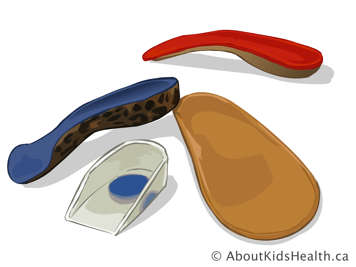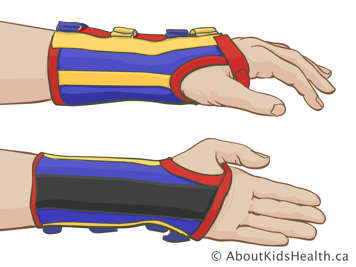Proper footwear is key to supporting the joints and body. Generally speaking, a good shoe is one that can be securely fastened, has a shock absorbing sole, a firm heel support, and a moderately flexible forefoot. Be sure that the shoes fit well. Ideally, the feet should be measured for length and width.
Tips for buying good footwear
- Shoe sizes are not standard. They will vary by style. Go by how the shoe feels, not what the number says.
- If one foot is bigger than the other or more troublesome, fit that one first.
- Try to find shoes that are available in different lengths and widths. Select a shoe that best fits your child's foot shape.
- When trying on shoes, have your child wear socks that they would normally wear.
- Take your child's orthotics or other inserts if they wear them.
- Be sure that there is room for the toes. Your child should be able to wiggle them freely inside the shoe. There should be a 1 cm space between the longest toe and the end of the shoe.
- Make sure the heel of the shoe is snug but comfortable. The shoe should have a rigid but cushioned heel. Your child's heel should not move around very much inside the shoe.
- Make sure the soles of the shoe are light, hard-wearing, and flexible.
- Be sure that the ball of the foot fits snugly at the widest part of the shoe.
- Leather uppers are often more comfortable. They allow the feet to breathe when the feet sweat.
- Shoes that lace up or fasten with Velcro provide more support than those that slip on.
- A supportive arch is preferred instead of a flat insole.
- Stand after trying the shoes on and walk around the floor. Make sure they are comfortable at the time. Don’t assume that they will “stretch” later. Your child should not have to “break in” a shoe if it fits properly.
- Try on several pairs!
Most often, a good supportive running or walking shoe provides enough support. Sometimes, the use of a shoe insert called an orthotic is also required. Orthotics can improve alignment, reduce pain, or accommodate for problems such as bunions (painful swelling on first joint of big toe). The majority of orthotics are worn inside the shoe. They do not look much different than other insoles. Many people today without JIA also wear orthotics. The illustration below shows a few examples of commonly used orthotics.

Supportive footwear
Many children and teens with JIA find it frustrating to wear running shoes or supportive footwear. Skate shoes, flip-flops and heels are often more fashionable and more accepted by peers. This may be where you need to compromise. For example, wearing a funky pair of wedges to a party once in a while, or flip-flops around the yard on a hot day, will not be harmful. It is important to wear a more comfortable and supportive shoe most of the time. This is most important when participating in sports or activities where your child is on their feet a lot.
Some young people with JIA have one leg that is shorter than the other. Usually this is a minor issue and does not require any treatment. For more significant differences, a shoe lift may be prescribed. An inner shoe lift fits inside the shoe. It can often be purchased over the counter. However, for lifts more than 1 cm, your child may need to see an orthotist, which is a person who makes orthopaedic devices. The orthotist may need to modify your child's shoe. Your child may need an outer shoe lift.
Splints

A splint is sometimes used to provide rest, support, and pain relief to a sore joint. Sometimes, splints may be helpful to stretch a joint to improve the range of motion. Occupational therapists are experts in advising and making splints. You can also buy some over the counter at drug stores or get a referral to an orthotist who specializes in making custom splints and orthotics.